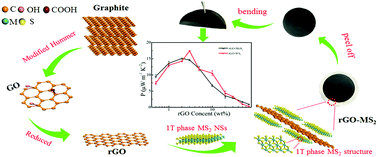Solution-processed two-dimensional layered heterostructure thin-film with optimized thermoelectric performance†
Abstract
Graphene-based two-dimensional (2D) heterostructures have ignited intensive interest in recent years because of their excellent physical performance. However, the most common method to prepare them uses chemical vapor deposition, which has the drawback of a complex process unsuitable for large-scale production. In this respect, reduced graphene oxide and transitional metal dichalcogenides (rGO–TMDs) composite thin-films were fabricated by a simple solution-processing method and their thermoelectric performance was investigated systematically. Addition of rGO nanosheets (NSs) efficiently improved the electrical conductivity of MoS2 and WS2 (MS2) NSs, due to the excellent electron transport performance of rGO. Furthermore, it should be noted that an optimized content of rGO can effectively avoid direct contact between TMDs NSs by forming a rGO–TMDs heterojunction, leading to significantly increased electrical conductivity and a slight variation in its Seebeck coefficient. Our work obtained high thermoelectric performance heterostructures by inducing two kinds of layered materials using a simple method that may potentially be applied to other 2D layered materials to construct heterostructures for energy conversion.



 Please wait while we load your content...
Please wait while we load your content...